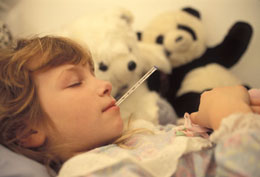Rheumatic fever is caused by the untreated streptococcus bacteria and can result in several symptoms throughout the body. This condition is considered to be quite a complex one and that is why the treatment of the same needs to be undertaken at the earliest.

Rheumatic fever is a medical condition that can be brought on after a strep throat infection, or after the body has been affected by a scarlet fever. This condition is caused by the streptococcus bacteria and leads to a cluster of symptoms that are unlike the ones that a regular fever leads to. This fever can be seen to affect the skin, the brain, joints, the heart, and the blood vessels as well. The bacteria makes way into the body and then settles. If the original condition is not treated, it can then lead to the emergence of this type of fever. In this following article, we will learn a little more about this condition and the ways in which the treatment of rheumatic fever in children can be undertaken.
Symptoms
Along with a study of the causes of this condition, one must also understand the symptoms of the same. When the bacteria enters the body through infections, and is left untreated, it settles in and then makes way as this complex condition that affects the human body and mind at varied levels. When it comes to children, the risks can get to be even more because they have a weaker immune system than adults. Here are some of the symptoms of rheumatic fever that can be studied.
- There can be swelling, pain, redness, and extreme tenderness in the child's joints. It might affect the knees, ankles, elbow, and wrists. The joints can also get filled with liquid and increase the pain further. This affects their regular movements and thereby leads to a whole lot of pain. The joints can get affected one after the other making the healing a long-drawn process.
- There can be a fever of varying degrees.
- Weight loss will start to make way as well.
- The child will complain of being fatigued and experiencing lack of energy which will affect all his/her regular functions.
- There will be a deterioration in the child's neuromuscular movements. This can be observed in the jerky movements that they exhibit in all functions (look for a change in handwriting).
- A skin rash that is reddish to pinkish in color will come about. This rash might be very abrasive to touch. It mostly comes over on the legs and hands.
- There might also be the emergence of small bumps under the skin. These can be very painful.
- The heartbeats can get to be extremely fast which is a sign of the heart becoming weak. This is usually a sign of acute rheumatic fever in children.
- Nausea, cough, vomiting, and dizziness are also seen as one of the most common signs of this fever.
Treatment
The treatment for rheumatic fever is undertaken with 3 objectives in mind. One, to treat the inflammation that has been caused. Two, to get rid of the bacteria. And three, to ensure that it does not make a comeback. This can be undertaken in the following ways.
Antibiotics will be administered to get rid of the inflammation that is brought on by the fever. The course is continued for a long period of time―maybe even years―so that the infection does not make a comeback.
Penicillin is also given for the same reasons―so that in case the streptococcal bacteria is still in the body, it can be destroyed.
Rest is important. It will ensure that a person does not undertake any stressful actions or come in contact with the bacteria. This measure is usually taken when the heart condition of the child is severely weakened.
It is important to not delegate a strep throat or a scarlet fever as something unimportant, and ensure that the child is treated for the same at the earliest. Other than that, the emergence of any of these signs should be gotten checked immediately enough and the treatment for the same started out as well.
Disclaimer -
This Buzzle article is for informative purposes only, and should not be used as a replacement for expert medical advice.


 Rheumatic fever is a medical condition that can be brought on after a strep throat infection, or after the body has been affected by a scarlet fever. This condition is caused by the streptococcus bacteria and leads to a cluster of symptoms that are unlike the ones that a regular fever leads to. This fever can be seen to affect the skin, the brain, joints, the heart, and the blood vessels as well. The bacteria makes way into the body and then settles. If the original condition is not treated, it can then lead to the emergence of this type of fever. In this following article, we will learn a little more about this condition and the ways in which the treatment of rheumatic fever in children can be undertaken.
Rheumatic fever is a medical condition that can be brought on after a strep throat infection, or after the body has been affected by a scarlet fever. This condition is caused by the streptococcus bacteria and leads to a cluster of symptoms that are unlike the ones that a regular fever leads to. This fever can be seen to affect the skin, the brain, joints, the heart, and the blood vessels as well. The bacteria makes way into the body and then settles. If the original condition is not treated, it can then lead to the emergence of this type of fever. In this following article, we will learn a little more about this condition and the ways in which the treatment of rheumatic fever in children can be undertaken.